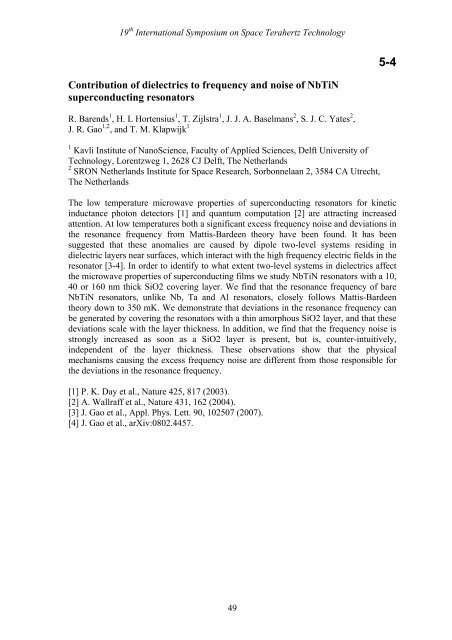Program and Abstract Book - SRON
Program and Abstract Book - SRON
Program and Abstract Book - SRON
Create successful ePaper yourself
Turn your PDF publications into a flip-book with our unique Google optimized e-Paper software.
19 th International Symposium on Space Terahertz Technology<br />
5-4<br />
Contribution of dielectrics to frequency <strong>and</strong> noise of NbTiN<br />
superconducting resonators<br />
R. Barends 1 , H. L Hortensius 1 , T. Zijlstra 1 , J. J. A. Baselmans 2 , S. J. C. Yates 2 ,<br />
J. R. Gao 1,2 , <strong>and</strong> T. M. Klapwijk 1<br />
1 Kavli Institute of NanoScience, Faculty of Applied Sciences, Delft University of<br />
Technology, Lorentzweg 1, 2628 CJ Delft, The Netherl<strong>and</strong>s<br />
2 <strong>SRON</strong> Netherl<strong>and</strong>s Institute for Space Research, Sorbonnelaan 2, 3584 CA Utrecht,<br />
The Netherl<strong>and</strong>s<br />
The low temperature microwave properties of superconducting resonators for kinetic<br />
inductance photon detectors [1] <strong>and</strong> quantum computation [2] are attracting increased<br />
attention. At low temperatures both a significant excess frequency noise <strong>and</strong> deviations in<br />
the resonance frequency from Mattis-Bardeen theory have been found. It has been<br />
suggested that these anomalies are caused by dipole two-level systems residing in<br />
dielectric layers near surfaces, which interact with the high frequency electric fields in the<br />
resonator [3-4]. In order to identify to what extent two-level systems in dielectrics affect<br />
the microwave properties of superconducting films we study NbTiN resonators with a 10,<br />
40 or 160 nm thick SiO2 covering layer. We find that the resonance frequency of bare<br />
NbTiN resonators, unlike Nb, Ta <strong>and</strong> Al resonators, closely follows Mattis-Bardeen<br />
theory down to 350 mK. We demonstrate that deviations in the resonance frequency can<br />
be generated by covering the resonators with a thin amorphous SiO2 layer, <strong>and</strong> that these<br />
deviations scale with the layer thickness. In addition, we find that the frequency noise is<br />
strongly increased as soon as a SiO2 layer is present, but is, counter-intuitively,<br />
independent of the layer thickness. These observations show that the physical<br />
mechanisms causing the excess frequency noise are different from those responsible for<br />
the deviations in the resonance frequency.<br />
[1] P. K. Day et al., Nature 425, 817 (2003).<br />
[2] A. Wallraff et al., Nature 431, 162 (2004).<br />
[3] J. Gao et al., Appl. Phys. Lett. 90, 102507 (2007).<br />
[4] J. Gao et al., arXiv:0802.4457.<br />
49
















